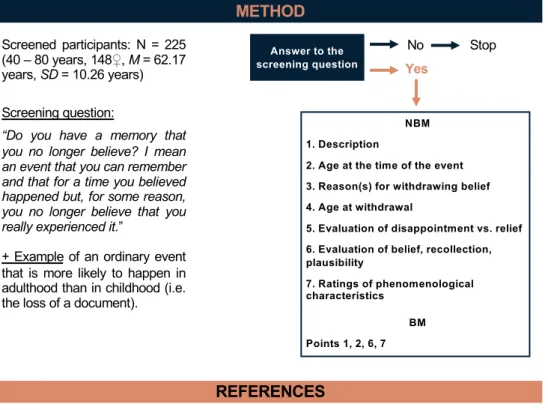BACKGROUND
METHOD
Screened participants: N = 225 (40 – 80 years, 148♀, M = 62.17 years, SD = 10.26 years) Screening question:“Do you have a memory that you no longer believe? I mean an event that you can remember and that for a time you believed happened but, for some reason, you no longer believe that you really experienced it.”
+ Example of an ordinary event that is more likely to happen in adulthood than in childhood (i.e. the loss of a document).
Answer to the screening question
NBM 1. Description
2. Age at the time of the event 3. Reason(s) for withdrawing belief 4. Age at withdrawal
5. Evaluation of disappointment vs. relief 6. Evaluation of belief, recollection, plausibility
7. Ratings of phenomenological characteristics
BM Points 1, 2, 6, 7
We can stop believing in memories of any age
Valentine Vanootighem & Serge Brédart
The results of the present study clearly challenge the notion that NBMs mainly relate to childhood events.
Our results suggest that:
Ø People may spontaneously report NBMs for events dating to adulthood when they are instructed that this particular type of memory may relate to adulthood events.
Ø NBMs may emerge for different reasons, depending on the time that the event occurred. Ø Overall the influence of temporal distance is similar on the ratings of BMs and NBMs.
CONCLUSIONS
RESULTS
FREQUENCY AND GENERAL CHARACTERISTICS OFNBMS
Frequency: 20%
Age at the time of the event:
M = 28.29, SD = 21.49, range = 2-73, Median = 20
Age at withdrawal:
M = 39.16, SD = 20.4 range = 7-75, Median = 40
REASONS FOR NO LONGER BELIEVING MEMORIES
Events dated to between age 2 and age 21
1.Social feedback (43.5%)
2.Event implausibility (21.7%)
3.External contradictory evidence (17.4%)
Events dated to 21 years or older
1.External contradictory evidence (86.4%)
2.Social feedback (18.2%)
PHENOMENOLOGICAL CHARACTERISTICS
Main effects of event type
- Higher ratings for BMs than for NBMs - BMs more often retrieved from a 1st person perspective than NBMs
Fig 1. Percentage of NBMs by age group
Main effect of temporal distance
- Distant events rated as more intense than recent events
Interactions
As the temporal distance from the present increased, 1) the level of perceived plausibility decreased significantly more for NBMs than for BMs, and 2) the amount of smell and taste details decreased for BMs but increased for NBMs.
The phenomenon through which an autobiographical memory is no longer believed to be a representation of an event that really happened, despite a vivid recollection of the event, has been termed a nonbelieved memory (NBM)2,3.
The age distribution of NBMs reported by young and older adults typically reflects a large proportion of events dated to childhood1,2,4. The present study aimed to further investigate the
age of origin of NBMs through the use of instructions that draw attention to the fact that NBMs could refer to adulthood events.
We also examined 1) whether the reason(s) given by participants may change in relation to the age at the time the event occurred, and 2) the influence of temporal distance on the phenomenological characteristics associated with believed and nonbelieved memories.
REFERENCES
(1) Brédart, S., & Bouffier, M. (2016). Nonbelieved memories in middle-aged and older people. Consciousness and Cognition, 42, 352– 357.
(2) Mazzoni, G., Scoboria, A., & Harvey, L. (2010). Nonbelieved memories. Psychological Science, 21, 1334–1340.
(3) Otgaar, H., Scoboria, A., & Mazzoni, G. (2014). On the existence and implications of nonbelieved memories. Current Directions in Psychological Science, 23, 349–354.
(4) Scoboria, A., Memon, A., Gawrylowicz, J., & Clark, A. (2015). Nonbelieved memories across the adult lifespan. Psychology of Consciousness: Theory, Reserch, and Practice, 2, 461–474.
No Stop Yes 48.9% 20% 24.4% 6.7% 0-3 years 4-12 years 13-20 years Above 21 years
